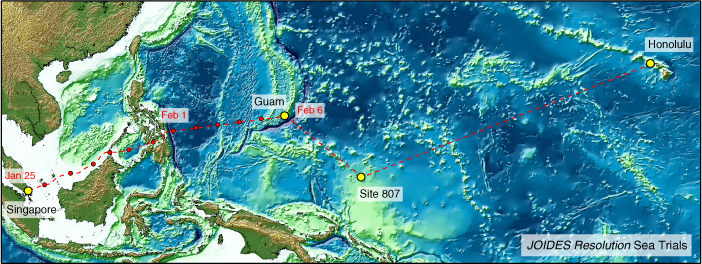Expedition 320T: Sea Trials Transit
Week 2 Report (1-7 February 2009)
PDF file is available for download.
8 February 2009
Operations
We continued to transit at full speed to Guam to pick up the Readiness Assessment Committee (RAC). Our speed was impacted by a strong head current of ~1.0 kt, variable headwinds that on some days attained 25 knots sustained with gusts to 40 knots, and problems with the propulsion electrical system. Initial electrical problems were related to inadequate ventilation causing overheating and subsequent failures in the aft thyrig room, which was resolved with adjustments of new HVAC and vent systems. An additional impact on our transit speed was related to new electrical breakers continually tripping when turns on the main screws were increased from 120 rpm to 130 rpm, which caused propulsion motors to kick off line. Toward the end of the week a team of engineers, ETs and electricians appear to have resolved this issue. Elevator and HVAC technicians were requested for the Guam port call to resolve problems remaining in these areas. Drilling package readiness efforts continued throughout the week. The ship arrived in Guam with first line ashore at 1830 hr on February 6. After clearance by US customs and immigrations officials the first vendors and HVAC and the elevator technicians boarded the ship.
Science and Analytical Systems Summary
The set-up of analytical systems continued during the week. Daily activities were filled with pre-acceptance testing and acceptance team meetings. A number of core loggers and analytical systems in the chemistry laboratory were accepted during this week. The plasma of the ICP-AES was ignited for the first time at sea. The instrument is now operational and is pending acceptance testing. The set up of the core receiving area was completed (e.g., outfitting with sampling and curation equipment). Wireline logging systems, including the new wireline heave compensator, are ready for deployment and testing.
The acceptance teams for SampleMaster and WebTabular (data capture and retrieving applications) continued testing and made significant progress in evaluating the software and providing input to developers. The acceptance team for DESCINFO (core description and paleontology) held its kick-off meeting and received a detailed introduction into the application and the overarching role of this system within the overall framework of the new data reporting and retrieval applications that surround the LIMS (Laboratory Information Management System) database. Acceptance testing will continue in conjunction with the RAC during sea trials. Planning and preparation for RAC arrival continued and by the end of the week a tentative schedule for sea trials and RAC activities was developed.
On February 7 the RAC arrived on board and received several introductory talks about life on board and had an extensive vessel transformation tour.
HSE Activities
The first lifeboat and fire drill in the open ocean was conducted early this week. Further details about boarding the lifeboats at sea were given by the nautical officers.
Transit Map

